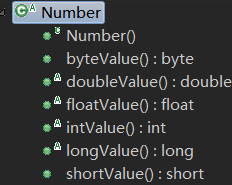包装类分析
Java 基本类型包括八种:byte、short、int、long、float、double、char、boolean
Number类型
其中数字类型包括:
整数型:
byte : -127~128
short : -32767~32768
int : 0x80000000~0x7fffffff
long : 0x8000000000000000L~0x7fffffffffffffffL
浮点型:
float : 0x0.000002P-126f / 0x1.fffffeP+127f
double : 0x0.0000000000001P-1022 ~ 0x1.fffffffffffffP+1023
java.lang.Number是数字类型对象的抽象类,子类包括Byte、Short、Integer、Long、Float、Double。还有BigDecimal和BigInteger
//定义非抽象方法byteValue 和shortValue
public byte byteValue() {
return (byte)intValue();
}
public short shortValue() {
return (short)intValue();
}
Byte
Byte中主要提供的方法有
- 构造方法
- toString
- decode 解码方法,包括二进制、八进制、十六进制 静态工厂方法
- compare 比较大小 静态工厂方法
- compareTo 比较大小
- valueOf 转换为Byte类型 静态工厂方法
- parseByte 转换为Byte类型
- intValue 类型转换 等类型转换方法
、、、decode、valueOf、parse
属性域
//最小值
public static final byte MIN_VALUE = -128;
//最大值
public static final byte MAX_VALUE = 127;
//声明类型
//获取JVM本地类型
public static final Class TYPE = (Class) Class.getPrimitiveClass("byte");
//二进制长度
public static final int SIZE = 8;
//byte存储
private final byte value;
//静态内部类
private static class ByteCache {
//不提供实例化方法
private ByteCache(){}
//缓存byte的所有值
//好处显而易见,使用比较多时节省内存空间
static final Byte cache[] = new Byte[-(-128) + 127 + 1];
static {
for(int i = 0; i < cache.length; i++)
cache[i] = new Byte((byte)(i - 128));
}
}
主要方法
//主要调用了Integer的parseInt方法
public static byte parseByte(String s, int radix)
throws NumberFormatException {
int i = Integer.parseInt(s, radix);
if (i < MIN_VALUE || i > MAX_VALUE)
throw new NumberFormatException(
"Value out of range. Value:\"" + s + "\" Radix:" + radix);
return (byte)i;
}
//调用了Integer.decode 八进制、十六进制转换
public static Byte decode(String nm) throws NumberFormatException {
int i = Integer.decode(nm);
if (i < MIN_VALUE || i > MAX_VALUE)
throw new NumberFormatException(
"Value " + i + " out of range from input " + nm);
return valueOf((byte)i);
}
//转换其他类型,直接进行强制转换,低级变量向高级变量转换
public double doubleValue() {
return (double)value;
}
parseType 与 valueOf方法的区别
//返回值是byte,相当于在栈中划分新的内存空间
public static byte parseByte(String s, int radix)
throws NumberFormatException {
int i = Integer.parseInt(s, radix);
if (i < MIN_VALUE || i > MAX_VALUE)
throw new NumberFormatException(
"Value out of range. Value:\"" + s + "\" Radix:" + radix);
return (byte)i;
}
//静态工厂方法,返回包装类,实际存储内容已经缓存在静态内部类中
public static Byte valueOf(String s, int radix)
throws NumberFormatException {
return valueOf(parseByte(s, radix));
}
Short
short属性域与Btye类似的,所差别的主要是值域范围
short的主要方法也类似于btye,调用的是Integer的方法
Integer
Integer静态域类似于Byte的静态域,包括范围和type。
Byte和Short的toString 都是调用Integer进行实现的。
//提供的进制转换支持字符,根据设定,最高支持36进制转换
final static char[] digits = {
'0' , '1' , '2' , '3' , '4' , '5' ,
'6' , '7' , '8' , '9' , 'a' , 'b' ,
'c' , 'd' , 'e' , 'f' , 'g' , 'h' ,
'i' , 'j' , 'k' , 'l' , 'm' , 'n' ,
'o' , 'p' , 'q' , 'r' , 's' , 't' ,
'u' , 'v' , 'w' , 'x' , 'y' , 'z'
};
//设置进制的toString
public static String toString(int i, int radix) {
//判断是否越界
if (radix < Character.MIN_RADIX || radix > Character.MAX_RADIX)
radix = 10;
//若为10进制,调用toString(int i)
if (radix == 10) {
return toString(i);
}
char buf[] = new char[33];
boolean negative = (i < 0);
int charPos = 32;
//判断正负
if (!negative) {
i = -i;
}
//辗转相除,存储到buff里
while (i <= -radix) {
buf[charPos--] = digits[-(i % radix)];
i = i / radix;
}
buf[charPos] = digits[-i];
if (negative) {
buf[--charPos] = '-';
}
//从数组尾部存储,创建String调用String的截取创建
return new String(buf, charPos, (33 - charPos));
}
//十进制String转换
public static String toString(int i) {
if (i == Integer.MIN_VALUE)
return "-2147483648";
//计算位数
int size = (i < 0) ? stringSize(-i) + 1 : stringSize(i);
char[] buf = new char[size];
getChars(i, size, buf);
return new String(buf, true);
}
//定义范围数组,确定String长度
final static int [] sizeTable = { 9, 99, 999, 9999, 99999,999999, 9999999,99999999, 999999999, Integer.MAX_VALUE };
// 计算输入值位数
static int stringSize(int x) {
for (int i=0; ; i++)
if (x <= sizeTable[i])
return i+1;
}
看到了Integer的getChars方法,开始没怎么看明白,附知乎大神解释
java源码中Integer.class中有个getChars方法,里面有个52429是怎么确定的?
